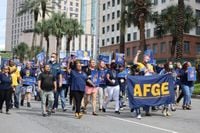In a significant turn of events on Capitol Hill, House lawmakers have rallied enough support to force a vote on the Protect America’s Workforce Act, a bill aiming to restore collective bargaining rights for federal employees that were stripped away by a controversial executive order earlier this year. The move, which has drawn attention from both sides of the political aisle, marks a rare display of bipartisan cooperation on a deeply contentious issue—one that could affect nearly a million federal workers across the country.
According to NPR, the drama began back in late March 2025, when President Trump signed an executive order directing around 20 federal agencies—including the Department of Veterans Affairs, the Social Security Administration, the Environmental Protection Agency, NASA, and the National Weather Service—to end collective bargaining rights for most federal workers. The White House justified the decision by citing national security concerns, arguing that union activities were obstructing agency management, especially in departments with sensitive responsibilities. The order, however, was met with immediate and fierce opposition from federal employee unions.
Everett Kelley, president of the American Federation of Government Employees (AFGE), which represents the majority of the roughly one million employees affected, minced no words in his response. “This isn’t about safety or security,” Kelley said, as reported by NPR. “It’s about silencing workers who are courageously standing up to this nonintegrity, to his nonaccountability in the government.” Kelley also described the executive order as “plainly retaliatory,” asserting that it was issued because AFGE was standing up for its members. The union didn’t just voice its discontent; it also filed lawsuits to block related actions, including mass layoffs and the termination of union contracts.
With tensions running high, the legislative battle lines were drawn. Representative Jared Golden, a Democrat from Maine, introduced the Protect America’s Workforce Act. The bill’s purpose was clear: overturn President Trump’s executive order and restore any collective bargaining agreements canceled since March. While the bill quickly attracted enough Republican co-sponsors to pass in the House, getting it to the floor for a vote was another matter entirely. House leadership, wary of taking on the White House, was reluctant to advance the legislation.
That’s when Golden and his allies turned to a procedural tool known as the discharge petition. This rarely used tactic allows rank-and-file lawmakers to bypass leadership and force a vote on a bill if they can gather 218 signatures—the majority threshold in the House. As Golden explained at a July press conference, “If every member who signed on to this bill would join us, we could overturn this union-busting action and show America that this body will protect workers’ rights, no matter what.”
The campaign for signatures was anything but easy, especially for Republicans facing pressure from party leadership and the White House. Yet, a handful broke ranks. Congressman Rob Bresnahan Jr. of Northeastern Pennsylvania was one of only five Republicans to sign the petition early on, back on September 2, 2025. For Bresnahan, the issue was personal. “This was just something that obviously hit home. It was the right thing to do, down to Tobyhanna Army Depot, where we have nearly 4,000 employees, to the VA hospital, to our IRS, to our Social Security Administration. We have our international airport. Everything that we talked about during the government shutdown and the federal employees were its 2.94% of our workforce are federal workers,” Bresnahan told local media.
Bresnahan’s district alone stands to see more than 10,000 federal workers affected by the legislation. He emphasized the uncertainty federal employees have faced—wondering if the government would reopen, whether they’d keep their jobs, or if they’d retain their right to collectively bargain. “We are an outlier when it comes to our workforce when nearly 3% of our workforce are federal workers. If you call the 1-800 number for the Social Security Administration, those numbers are routed through Wilkes-Barre. You think about the volume, the workload, and obviously just the uncertainty of when was the government going to reopen or am I going to have my ability to collectively bargain?” Bresnahan reflected.
The discharge petition gathered momentum, and by November 19, 2025, it had reached the critical 218-signature mark. Among the last to sign were Republicans Nick LaLota and Michael Lawler of New York, who joined the petition on Monday of that week. Lawler, in a statement posted to his website and cited by NPR, wrote, “Supporting workers and ensuring good government are not opposing ideas.” Their signatures ensured that the House would be required to take up the Protect America’s Workforce Act, despite earlier leadership resistance.
If enacted, the bill would reverse the executive order and restore collective bargaining protections to roughly 67% of the entire federal workforce nationwide. That’s a staggering number—about two-thirds of all federal employees, according to estimates reported by local Pennsylvania media. The legislation would also reinstate any collective bargaining agreements that had been canceled since March, providing a measure of stability for workers who have faced months of uncertainty.
The path forward, however, is not without obstacles. The House is now obligated to schedule a vote on the bill, which could happen as soon as December 2025. Bresnahan, for one, expects strong bipartisan support when the vote is finally held. “I think this will be something that will pass the House overwhelmingly. I don’t see much pushback. I think you’re going to have different opinions, different ideologies,” he said.
Yet, even if the bill clears the House, its fate in the Senate remains far from certain. As NPR’s Andrea Hsu noted, “If the bill passes, it would move on to the Senate, where it’s far less clear there are enough Republicans willing to defy the president.” The Senate, often more cautious and less susceptible to grassroots pressure than the House, could prove a formidable hurdle for proponents of the legislation.
For now, though, federal workers and their advocates are celebrating a rare victory in a year marked by labor strife and political polarization. The successful discharge petition represents not only a procedural triumph but also a signal that, on some issues, lawmakers are willing to cross party lines in defense of workers’ rights. Whether that spirit of bipartisanship carries through to the final passage of the Protect America’s Workforce Act remains to be seen, but the stakes—for the federal workforce and the broader debate over labor rights in America—could hardly be higher.
The coming weeks will reveal whether this moment of unity in the House can translate into lasting change for the nation’s public servants, or whether partisan divisions will once again halt progress at the Senate’s doorstep.






